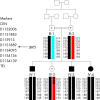Reduced bone mineral density and hyaloid vasculature remnants in a consanguineous recessive FEVR family with a mutation in LRP5
- PMID: 16929062
- PMCID: PMC1857417
- DOI: 10.1136/bjo.2006.092114
Reduced bone mineral density and hyaloid vasculature remnants in a consanguineous recessive FEVR family with a mutation in LRP5
Abstract
Background/aims: Familial exudative vitreoretinopathy (FEVR) is an inherited blinding condition characterised by abnormal development of the retinal vasculature. FEVR has multiple modes of inheritance, and homozygous mutations in LRP5 have recently been reported as underlying the recessive form of this disease. The aim of this study was to examine LRP5 in a consanguineous recessive FEVR family and to clarify the eye and bone phenotype associated with recessive FEVR.
Methods: All family members were examined by slit lamp biomicroscopy and indirect ophthalmoscopy. Linkage to LRP5 was determined by genotyping microsatellite markers, constructing haplotypes and calculating lod scores. Mutation screening of LRP5 was performed by polymerase chain reaction amplification of genomic DNA followed by direct sequencing. Bone mineral density (BMD) was evaluated in all family members using dual energy x ray absorptiometry (DEXA).
Results: The clinical features observed in this family were consistent with a diagnosis of recessive FEVR. A homozygous LRP5 missense mutation, G550R, was identified in all affected individuals and all unaffected family members screened were heterozygous carriers of this mutation. Reduced BMD, hyaloid vasculature remnants, and nystagmus were features of the phenotype.
Conclusion: Recessive mutations in LRP5 can cause FEVR with reduced BMD and hyaloid vasculature remnants. Assessment of a patient with a provisional diagnosis of FEVR should therefore include investigation of BMD, with reduced levels suggestive of an underlying LRP5 mutation.
Conflict of interest statement
The authors have no competing interests.
Similar articles
-
LRP5 BIALLELIC MUTATIONS CAUSE A HIGHER INCIDENCE OF SEVERE PHENOTYPE COMPARED WITH LRP5 MONOALLELIC MUTATION.Retina. 2022 Oct 1;42(10):1958-1964. doi: 10.1097/IAE.0000000000003543. Retina. 2022. PMID: 36018796
-
Whole Exome Sequencing Analysis Identifies Mutations in LRP5 in Indian Families with Familial Exudative Vitreoretinopathy.Genet Test Mol Biomarkers. 2016 Jul;20(7):346-51. doi: 10.1089/gtmb.2015.0322. Epub 2016 May 26. Genet Test Mol Biomarkers. 2016. PMID: 27228167
-
Molecular Characterization of FZD4, LRP5, and TSPAN12 in Familial Exudative Vitreoretinopathy.Invest Ophthalmol Vis Sci. 2015 Aug;56(9):5143-51. doi: 10.1167/iovs.14-15680. Invest Ophthalmol Vis Sci. 2015. PMID: 26244290
-
Familial exudative vitreoretinopathy and related retinopathies.Eye (Lond). 2015 Jan;29(1):1-14. doi: 10.1038/eye.2014.70. Epub 2014 Oct 17. Eye (Lond). 2015. PMID: 25323851 Free PMC article. Review.
-
Familial Exudative Vitreoretinopathy With a Novel LRP5 Mutation.J Pediatr Ophthalmol Strabismus. 2016 Jul 30;53:e39-42. doi: 10.3928/01913913-20160719-02. J Pediatr Ophthalmol Strabismus. 2016. PMID: 27486893 Review.
Cited by
-
Novel mutations affecting LRP5 splicing in patients with osteoporosis-pseudoglioma syndrome (OPPG).Eur J Hum Genet. 2011 Aug;19(8):875-81. doi: 10.1038/ejhg.2011.42. Epub 2011 Mar 16. Eur J Hum Genet. 2011. PMID: 21407258 Free PMC article.
-
Identification of two novel LRP5 mutations in families with familial exudative vitreoretinopathy.Mol Vis. 2014 Mar 29;20:395-409. eCollection 2014. Mol Vis. 2014. PMID: 24715757 Free PMC article.
-
Pharmacologic Activation of Wnt Signaling by Lithium Normalizes Retinal Vasculature in a Murine Model of Familial Exudative Vitreoretinopathy.Am J Pathol. 2016 Oct;186(10):2588-600. doi: 10.1016/j.ajpath.2016.06.015. Epub 2016 Aug 12. Am J Pathol. 2016. PMID: 27524797 Free PMC article.
-
Mutation spectrum of the Norrie disease pseudoglioma (NDP) gene in Indian patients with FEVR.Mol Vis. 2016 May 16;22:491-502. eCollection 2016. Mol Vis. 2016. PMID: 27217716 Free PMC article.
-
Genetic detection of two novel LRP5 pathogenic variants in patients with familial exudative vitreoretinopathy.BMC Ophthalmol. 2023 Nov 29;23(1):489. doi: 10.1186/s12886-023-03243-2. BMC Ophthalmol. 2023. PMID: 38030997 Free PMC article.
References
-
- Criswick V G, Schepens C L. Familial exudative vitreoretinopathy. Am J Ophthalmol 196968578–594. - PubMed
-
- Miyakubo H, Hashimoto K, Miyakubo S. Retinal vascular pattern in familial exudative vitreoretinopathy. Ophthalmology 1984911524–1530. - PubMed
-
- Van Nouhuys C E. Dominant exudative vitreoretinopathy and other vascular developmental disorders of the peripheral retina. Doc Ophthalmol 1982541–414. - PubMed
Publication types
MeSH terms
Substances
Grants and funding
LinkOut - more resources
Full Text Sources
Medical
Molecular Biology Databases



